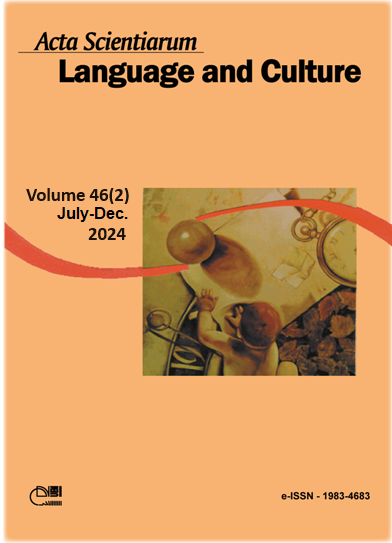A utilização de pronomes não binários no português brasileiro: um estudo exploratório com dados da rede social X
Resumen
O presente trabalho possui como objetivo verificar e analisar os usos de uma terceira marca de gênero no português brasileiro, realizado na utilização de neopronomes, como nos sistemas ‘elu’, ‘ile’, ‘ilu’ e ‘el’, e na ampliação de marcas distintivas de gênero na língua, tal como o uso do -e no final de nomes. A justificativa desta investigação é pautada na novidade do fenômeno na língua e, de forma consequente, nos estudos linguísticos, formando-se como uma nova problemática de investigação. Para tanto, lançamos mão de estudos sobre a categoria de gênero gramatical desenvolvidos por Câmara Jr. (1970), Rocha (1998) e Corbett (1991). Destacam-se também os estudos de Benveniste (1995) e Neves (2000) sobre a classe dos pronomes, com intuito de compreender a implementação dos neopronomes e a sua relação com um novo valor de gênero. Além do trabalho de Hall (2006) que permeia as questões de identidade dos sujeitos. Desse modo, a partir de uma coleta de dados realizada na rede social X, por meio de um procedimento de raspagem, foram analisados os usos dos neopronomes no português brasileiro. Nesse sentido, os 364 dados de neopronomes foram submetidos a uma análise estatística, utilizando a plataforma R, na qual foi observada a proporção de frequência de uso, o contexto semântico desses usos e o padrão de concordância nominal desencadeado pelos neopronomes. Assim, como resultado foi observado que o sistema ‘elu’ apresentou uma maior frequência de usos. Além disso, as utilizações de neopronomes apresentaram uma maior relevância para uma referência genérica dos sujeitos, recuperando identidades binárias e não binárias na língua, e pouco impacto no padrão de concordância da língua.
Descargas
Citas
Referências
Almeida, G. C. (2020). Manual para o uso da linguagem neutra em língua portuguesa. Research Gate. Recuperado de https://www.researchgate.net/publication/341736329_Manual_para_o_uso_da_linguagem_neutra_em_Lingua_Portuguesa
Bagagli, B. P. (2018). “Cisgênero” nos discursos feministas: uma palavra “tão defendida, tão atacada, tão pouco entendida”. Campinas, SP: Unicamp.
Baldez, D. S. (2022). O uso da marcação de gênero neutro no Twitter por uma perspectiva sociolinguística (Dissertação de Mestrado). Pontifícia Universidade Católica do Rio Grande do Sul, Porto Alegre, Rio Grande do Sul.
Baldez, D. S. (2024). Todes elus: uma análise sociolinguística sobre o emprego do gênero neutro no twitter. Travessias Interativas, 14(31), 39-55. DOI: https://doi.org/10.51951/ti.v14i31.p39-55
Benveniste, É. (1995). A natureza dos pronomes. In É. Benveniste, Problemas de linguística geral (4a ed., p. 277-283). São Paulo, SP: Pontes.
Câmara Jr., J. M. (1970). Estrutura da língua portuguesa (2a ed.). Petrópolis, RJ: Vozes.
Cambridge Dictionary Online (2024). Neopronoun. Recuperado de https://dictionary.cambridge.org/pt/dicionario/ingles/neopronoun
Cassiano, O. (2019, 30 set.). Guia para “linguagem neutra” (PT-BR). Medium. Recuperado de http://medium.com/guia-para-linguagem-neutra-pt-br/guia-para-linguagem-neutra-pt -br-f6d88311f92b
Corbett, G. G. (1991). Gender. Cambridge, GB: Cambridge University Press.
Freitag, R. M. K. (2022). Conflito de regras e dominância de gênero. In F. R. Barbosa Filho, G. Á. Othero (Orgs.), Linguagem "neutra": língua e gênero em debate (p. 53-72). São Paulo, SP: Parábola.
Hall, S. (2006). A identidade cultural na pós-identidade (11a ed.). Rio de Janeiro, RJ: DP&A.
Neves, M. H. M. (2000). Gramática de usos do português. São Paulo, SP: Unesp.
Rocha, L. C. A. (1998). Estruturas morfológicas do português. Belo Horizonte, MG: Martins Fontes.
Schwindt, L. C. (2020). Sobre gênero neutro em português brasileiro e os limites do sistema linguístico. Revista da ABRALIN, 19(1), 1-23. DOI: https://doi.org/10.25189/rabralin.v19i1.1709
Stetie, N. A., Rebolledo, C. M., & Zunino, G. M. (2023). Diversidad de género y variación lingüística en el español de América: procesamiento de estereotipos y morfología de género en Argentina y Chile. Revista de Estudos da Linguagem, 31(2), 636-687. DOI: https://doi.org/10.17851/2237-2083.31.2.636-687
DECLARAÇÃO DE ORIGINALIDADE E DIREITOS AUTORAIS
Declaro que o presente artigo é original, não tendo sido submetido à publicação em qualquer outro periódico nacional ou internacional, quer seja em parte ou em sua totalidade.
Os direitos autorais pertencem exclusivamente aos autores. Os direitos de licenciamento utilizados pelo periódico é a licença Creative Commons Attribution 4.0 (CC BY 4.0): são permitidos o acompartilhamento (cópia e distribuição do material em qualqer meio ou formato) e adaptação (remix, transformação e criação de material a partir do conteúdo assim licenciado para quaisquer fins, inclusive comerciais.
Recomenda-se a leitura desse link para maiores informações sobre o tema: fornecimento de créditos e referências de forma correta, entre outros detalhes cruciais para uso adequado do material licenciado.




















6.png)









